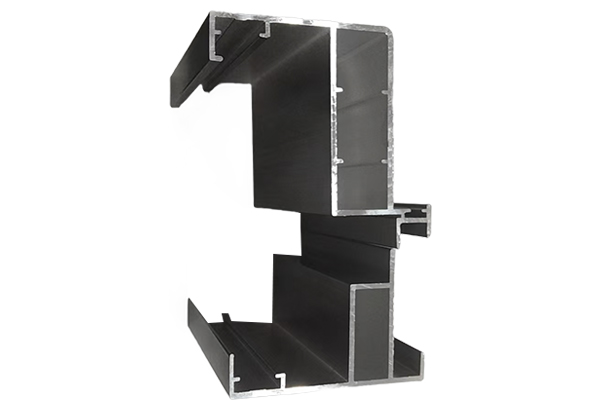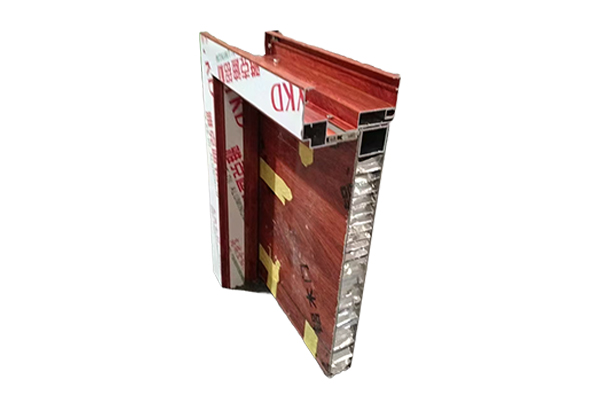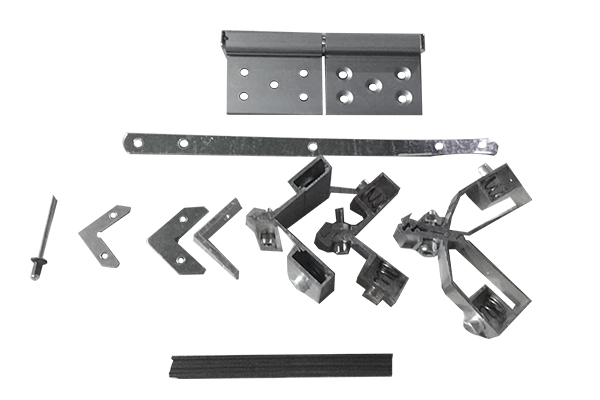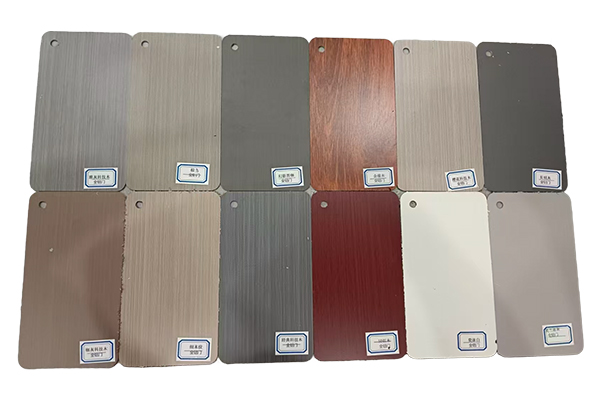Why does the honeycomb door panel's honeycomb structure achieve the perfect balance between lightweight and high strength for aluminum doors?
Release Time : 2025-08-18
The key to making the honeycomb door panel a prominent choice in modern high-end aluminum door design lies in its unique internal honeycomb structure. This biomimetic design, inspired by the hexagonal arrangement of beehives in nature, achieves a high degree of optimization between material efficiency and structural performance through scientific mechanical distribution. This structure enables aluminum doors to maintain exceptional load-bearing capacity and deformation resistance while remaining lightweight, achieving a harmonious balance between lightweight and high strength.
Traditional door panels often rely on increasing material thickness or density to enhance strength, but this approach inevitably increases weight, burdening hardware and placing higher demands on wall structure and opening experience. Honeycomb door panels, on the other hand, utilize a sandwich construction: an outer layer of high-strength aluminum alloy panels and an inner layer of a honeycomb core made of aluminum foil or paper-based materials, securely bonded together through a precision composite process. This structure minimizes material filler without sacrificing strength, significantly reducing the overall weight of the door.
The core advantage of the honeycomb structure lies in the mechanical rationality of its geometric form. The hexagonal honeycomb cells are closely arranged, forming a stable triangular support system. When external forces act on the door panel surface, the load is quickly distributed throughout the structural network through the honeycomb walls, preventing stress concentration at a single point. This uniform force transmission mechanism ensures excellent bending stiffness and resistance to flexure when subjected to compression, bending, or impact. Even in large door leaf applications, it effectively prevents sagging, twisting, or deformation caused by weight or external forces.
Furthermore, the honeycomb structure is filled with air, creating numerous enclosed microcavities. These cavities not only reduce overall mass but also act as a buffer. When the door panel is subjected to localized impact, the honeycomb core absorbs energy through elastic deformation, minimizing direct damage to the outer aluminum plate. This "softness overcomes rigidity" property makes the door more resistant to bumps and vibrations during daily use, extending its service life.
The benefits of lightweighting are not only reflected at the structural level but also profoundly impact the overall user experience. Lighter door panels reduce the load on hardware such as hinges and rails, reducing the risk of wear and tear over time and enhancing smoother and quieter opening and closing. For sliding, folding, or suspended doors, the lightweight, high-strength honeycomb door panel is essential for flexible movement and stable operation. Furthermore, in high-rise buildings or spaces with sensitive load-bearing requirements, lightweight door bodies help reduce the overall building load, aligning with green and energy-saving design trends.
The honeycomb structure also provides additional functional advantages for door panels. The enclosed air cavity provides excellent thermal resistance, effectively slowing heat transfer and improving the thermal insulation performance of the door. Furthermore, sound waves are attenuated by multiple reflections and attenuation as they pass through the honeycomb layer, enhancing sound insulation. These additional properties further enhance the suitability of honeycomb aluminum doors for residential, office, and hotel environments.
Furthermore, the manufacturing process of honeycomb door panels is highly controllable, allowing for standardized production in factories, ensuring structural consistency and consistent quality for each door panel. By adjusting the density, thickness, and composite process of the honeycomb core, performance can be optimized for different usage scenarios, meeting diverse needs from homes to commercial spaces.
In summary, the honeycomb structure, through its scientific geometric arrangement and material distribution, organically combines the seemingly contradictory properties of "lightness" and "strength." It is not just a structural form, but also a manifestation of the intelligent and efficient use of materials. It is precisely this inherent mechanical wisdom that makes the honeycomb door panel an ideal solution for modern aluminum doors, achieving a balance between lightness and high strength, providing a safer, more durable, and more flexible door system option for architectural spaces.
Traditional door panels often rely on increasing material thickness or density to enhance strength, but this approach inevitably increases weight, burdening hardware and placing higher demands on wall structure and opening experience. Honeycomb door panels, on the other hand, utilize a sandwich construction: an outer layer of high-strength aluminum alloy panels and an inner layer of a honeycomb core made of aluminum foil or paper-based materials, securely bonded together through a precision composite process. This structure minimizes material filler without sacrificing strength, significantly reducing the overall weight of the door.
The core advantage of the honeycomb structure lies in the mechanical rationality of its geometric form. The hexagonal honeycomb cells are closely arranged, forming a stable triangular support system. When external forces act on the door panel surface, the load is quickly distributed throughout the structural network through the honeycomb walls, preventing stress concentration at a single point. This uniform force transmission mechanism ensures excellent bending stiffness and resistance to flexure when subjected to compression, bending, or impact. Even in large door leaf applications, it effectively prevents sagging, twisting, or deformation caused by weight or external forces.
Furthermore, the honeycomb structure is filled with air, creating numerous enclosed microcavities. These cavities not only reduce overall mass but also act as a buffer. When the door panel is subjected to localized impact, the honeycomb core absorbs energy through elastic deformation, minimizing direct damage to the outer aluminum plate. This "softness overcomes rigidity" property makes the door more resistant to bumps and vibrations during daily use, extending its service life.
The benefits of lightweighting are not only reflected at the structural level but also profoundly impact the overall user experience. Lighter door panels reduce the load on hardware such as hinges and rails, reducing the risk of wear and tear over time and enhancing smoother and quieter opening and closing. For sliding, folding, or suspended doors, the lightweight, high-strength honeycomb door panel is essential for flexible movement and stable operation. Furthermore, in high-rise buildings or spaces with sensitive load-bearing requirements, lightweight door bodies help reduce the overall building load, aligning with green and energy-saving design trends.
The honeycomb structure also provides additional functional advantages for door panels. The enclosed air cavity provides excellent thermal resistance, effectively slowing heat transfer and improving the thermal insulation performance of the door. Furthermore, sound waves are attenuated by multiple reflections and attenuation as they pass through the honeycomb layer, enhancing sound insulation. These additional properties further enhance the suitability of honeycomb aluminum doors for residential, office, and hotel environments.
Furthermore, the manufacturing process of honeycomb door panels is highly controllable, allowing for standardized production in factories, ensuring structural consistency and consistent quality for each door panel. By adjusting the density, thickness, and composite process of the honeycomb core, performance can be optimized for different usage scenarios, meeting diverse needs from homes to commercial spaces.
In summary, the honeycomb structure, through its scientific geometric arrangement and material distribution, organically combines the seemingly contradictory properties of "lightness" and "strength." It is not just a structural form, but also a manifestation of the intelligent and efficient use of materials. It is precisely this inherent mechanical wisdom that makes the honeycomb door panel an ideal solution for modern aluminum doors, achieving a balance between lightness and high strength, providing a safer, more durable, and more flexible door system option for architectural spaces.







